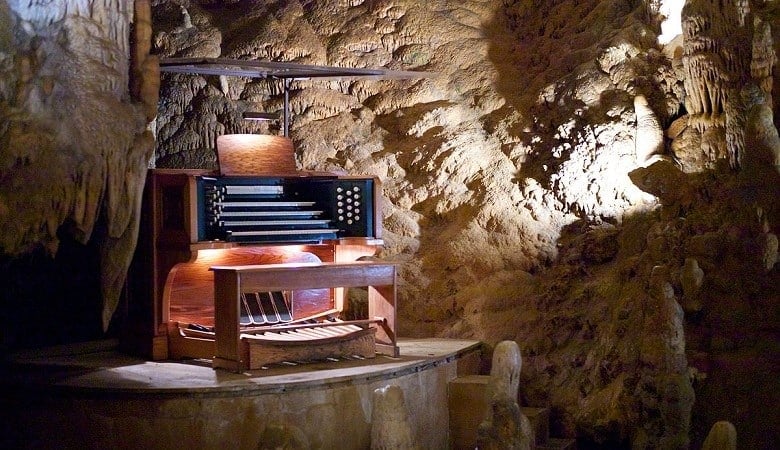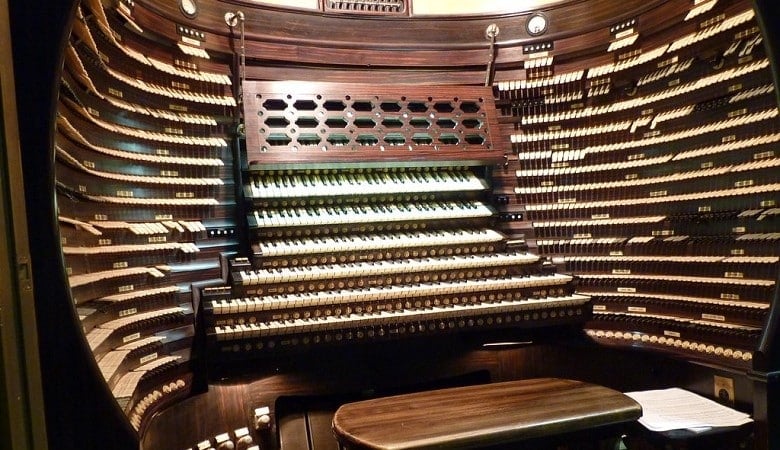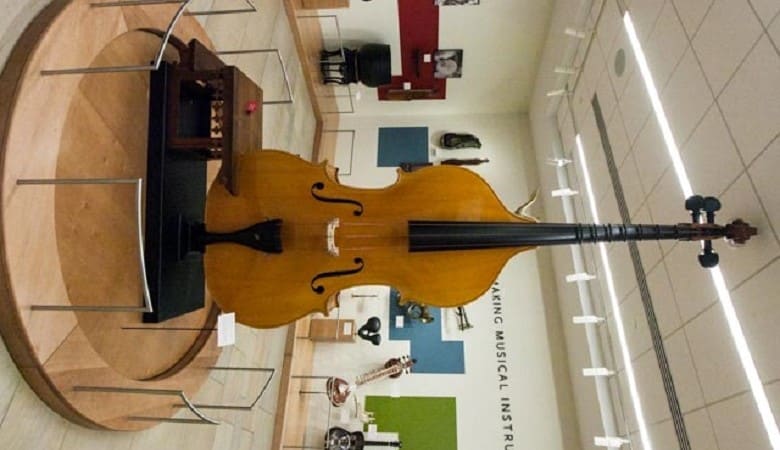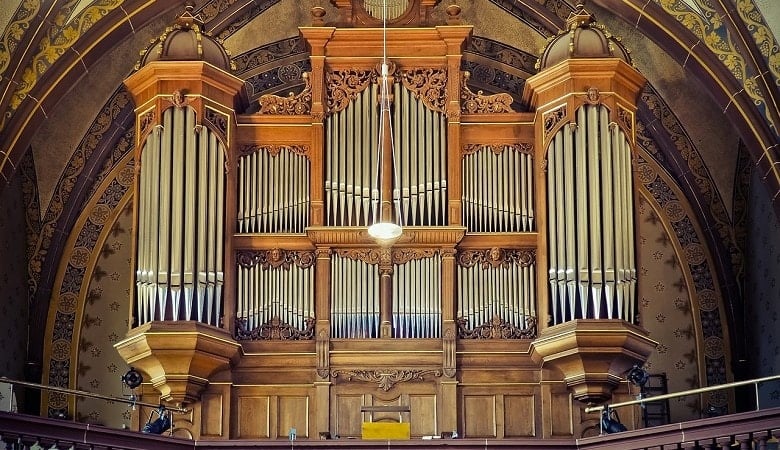Music is life —- so they say. If music is life, then there’s nobody alive that has never heard a form of music. The beautiful thing about music is that it can be made anywhere and from anything. Everything around us can become a musical instrument provided it produces any kind of sound.
However they are instruments that have been made specifically made for that purpose and although it is impossible to create an exhaustive list of these instruments, this piece seeks to bring to your knowledge some of the heaviest musical instruments ever made and intriguing facts about these enormous instruments.
1. The Earth Harp
The earth harp has been perfectly described by many as the intersection of music and architecture and sincerely it’s nothing short of that. The body of the harp sits onstage with strings that shoot out over the audience to the back of the auditorium, with strings that are 1,000 feet long (or attached to landmarks if outside).
William Close the inventor of the Earth Harp is a finalist in the popular America’s Got Talent show and he got to that stage by playing the Earth Harp. The invention of the Harp all started when he transformed a valley into a big harp, and he was inspired by installation artist Christo. The statement by Frank Lloyd Wright, “Architecture is frozen music,” has also long inspired Close.
Playing the harp, If you pluck strings in one room, it resonates through the others, like a harp with strings on the walls. It looks insanely satisfying to play an instrument so big although it requires a lot of work.
2. The Great Stalacpipe Organ

The Great Stalacpipe Organ is a creation of a pentagon mathematician and electronic scientist Leland Sprinkle in conjunction with Mother Earth. Located deep inside Virginia’s Luray Caverns, this organ is technically not an organ at all, but a percussion instrument known as a lithophone. Instead of pumping air through pipes, it works by striking 37 separate stalactites over the 3.5-acre cave in a repetitive pattern.
The stalacpipe organ is the world’s largest instrument, according to the Guinness Book of World Records. The organ’s chosen stalactites cover 3.5 acres in order to produce a precise musical scale, yet due to the cavern’s contained structure, the whole sound may be heard anywhere within the cavern.
3. The Symphonic House

Driven by a burning passion to build something beyond ordinary, the Suttons Bay architect, David Hanawalt in collaboration with Bill Close, an outstanding Sonic installation artist.
Through the design of buildings as musical instruments, The House explores the confluence of place, sight, and sound.
The house is fitted out with a series of musical instruments. The architecture serves as the instrument’s structure, bridge, and resonator, with specially developed brass and piano wire serving as the instrument’s “strings.” The utilization of Bill Close’s long string technologies allows the instruments to be architectural in scale. The intricate string patterns are extensions of the house’s architectural lines, and they constitute an intrinsic part of the visual experience.
According to Bill Close,” the house gives you a connection to the architecture that you wouldn’t normally have; the tones are so rich, they resonate in your body, within your bones”.
The ultimate result is a 6,200-square-foot, $2.4 million concrete and wood house with Scandinavian and Japanese touches, nestled on a far northern Lake Michigan shoreline.
4. The world’s largest tuba (Big Carl)
This tuba is the largest in the world. Or, as Carl Fischer Music puts it, “what some believe to be the world’s largest tuba.” It was built in 1900 and is rather huge, as one might anticipate. It’s so big that it requires two people to play it — and an estimated four lungs.
It’s not playable like a regular tuba, but since it looks like a tuba and sounds like one then it is a tuba.
A normal tuba stands approximately 3 1/2 feet tall, contains about 18 feet of tubing, and weighs approximately 20 pounds. Big Carl is approximately 8 feet tall, has 60 feet of tubing, weighs around 100 pounds, and pitches at a subcontrabass BBBb. His bell has a diameter of a little over 40 inches at its widest point.
It used to be on display at the Carl Fischer music store in Cooper Square, in Lower Manhattan, but is now hidden away on an upper story of the music publisher’s Wall Street offices.
5. The Boardwalk Hall Auditorium Organ

The Boardwalk Hall Auditorium Organ was built by the Midmer-Losh Organ Company and is located in the Main Auditorium of the Boardwalk Hall (previously known as the Atlantic City Convention Hall) in Atlantic City, New Jersey. According to the number of pipes, it is the world’s largest organ (officially around 33,112, but the exact number is unknown).
The organ is included in Guinness World Records as the “largest pipe organ ever created,” “largest musical instrument ever constructed,” and “loudest musical instrument ever constructed,” among other titles, and it holds multiple records in the organ world.
It’s one of only two open 64-foot ranks in the world, and the only organ with stops voiced at 100 inches of wind pressure (about 3.6 psi). There are seven manuals on the console.
6. CheonGo (world’s largest drum)
This drum was built by Yeong Dong-Gun local government and Seuk Je Lee in Simcheon-Meon, South Korea, and is 5.54 m (18 ft 2 in) in diameter, 5.96 m (19 ft 6 in) tall, and weighs 7 tonnes (15,432 kg 5.76 oz). It is recognized by the world Guinness book of records as the world’s largest drum ahead of the Purdue drum erroneously believed by most to be the world’s largest drum.
7. The Octobass

The Octobass is a chuffing enormous double bass that stands at 3.48m tall, built in 1850 by certifiable genius and admirer of massive string instruments Jean-Baptiste Vuillaume. This is insane, given that it’s too enormous to play with your hands – there are complicated foot-pedals to help.
Berlioz was apparently a fan, as evidenced by his mention of it in his dissertation on orchestration. It’s a raging beast in terms of sound. Certain notes go below the human hearing threshold.
8. Sound organ

This architectural piece is more of an experimental instrument and is located in Zadar, Croatia. The player is not a person, but rather the sea waves, who play the instrument through tubes hidden beneath a set of enormous marble steps. The notes are played at random (in accordance with the waves), but they have a harmonic sound to them.
9. The world’s biggest violin
Ekkard Seidl, a master luthier from Markneukirchen, designed this magnificent instrument. Despite its five-meter height, it has the dimensions of a standard-sized violin. The instrument took 15 luthiers about 2000 hours to create, but it’s all playable, setting a world record in the process.
A standard violin is between 14 and 23 inches in length (for children) (for adults). This violin stands at a height of 14 feet. It has a longer bow (almost 17 feet) that requires three people to operate. It is over 290 pounds in weight (and the bow alone is about 110).
It has a three-octave lower pitch than a standard violin, and each player has their sheet music. It was awarded the Guinness World Record and Stephan Konig composed a piece called “a rhapsody for enormous violin and orchestra” expressly for it.






